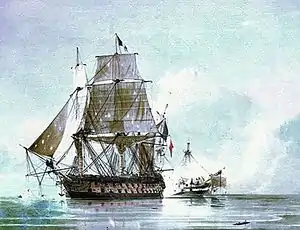French ship Généreux (1785)
Généreux was a French Téméraire-class 74-gun ship of the line. After capture she completed her career as part of the Royal Navy as HMS Généreux.
 Le Généreux in action against HMS Leander | |
| History | |
|---|---|
| Name | Généreux |
| Namesake | Generosity |
| Builder | Rochefort shipyard |
| Launched | 12 June (or July) 1785 |
| Captured | by Britain, 1800 |
| Name | Généreux |
| Acquired | 1800 |
| Nickname(s) | Jenny Rooks[1] |
| Fate | Broken up in 1816 |
| General characteristics [2] | |
| Class and type | Téméraire-class ship of the line |
| Displacement |
|
| Length | 55.87 metres (183.3 ft) (172 pied) |
| Beam | 14.90 metres (48 ft 11 in) |
| Draught | 7.26 metres (23.8 ft) (22 pied) |
| Propulsion | Up to 2,485 m2 (26,750 sq ft) of sails |
| Armament |
|
History
She was launched in 1785 at Rochefort. Under Louis-Jean-Nicolas Lejoille, she was one of only two ships to escape the British attack at the Battle of the Nile in August 1798, along with Guillaume Tell.
Shortly after the battle of the Nile, on 18 August 1798, she fell in with a smaller British ship of the line, HMS Leander of 50 guns. After a long battle, the Généreux captured the Leander, with the Leander suffering 35 killed and 57 wounded and the Généreux suffered around 100 killed and 180 wounded.[3]
In March 1799, Généreux escorted a convoy to Corfu, which was being besieged by a joint Russo-Ottoman fleet. En route, her captain, Lejoille, decided to bombard Brindisi. He was killed in the ensuing exchange of fire, and lieutenant Claude Touffet took over. The city fell on 3 March after a two-hour battle.[4]
On 6 February 1800, Généreux, under Captain Renaudin,[5] departed from Toulon leading a squadron comprising the frigate Badine, the corvettes Sans Pareille and Fauvette, and the fluyt Ville de Marseille, under Rear-Admiral Jean-Baptiste Perrée. In the morning of 18 February, an English fleet chased the French squadron off Lampedusa island. In the ensuing Battle of the Malta Convoy, Perrée was killed, and Généreux covered the squadron, allowing Badine, Sans Pareille and Fauvette to escape, before striking her colours. Her battle ensign, a 16 m by 8.3 m tricolour, was given to the city of Norwich by Berry and Nelson. The flag has been preserved; its size and completeness marking it as a special artefact of the period.[6]
She became HMS Généreux and she was in Minorca in 1801 when she press-ganged a crew from the Walmesley. She engaged Spanish ships and she was intended to go to Egypt. Storm damage prevented this so she patrolled off what is now Libya. After taking part in an unsuccessful attack on the French island of Elba, she set sail from Minorca for Spithead after peace was declared. She arrived at Spithead on 27 July 1802.[7] She was finally broken up in 1816.
See also
Citations
- Kennedy, Don H. (1974). Ship Names: Origins and Usages during 45 Centuries. Charlottesville: University Press of Virginia. p. 100. ISBN 0-8139-0531-1.
- Clouet, Alain (2007). "La marine de Napoléon III : classe Téméraire - caractéristiques". dossiersmarine.free.fr (in French). Archived from the original on 23 March 2013. Retrieved 4 April 2013.
- Phillips, Michael (2013). "LEANDER (50) [1780]". Ships of the Old Navy. Retrieved 4 April 2013.
- Dictionnaire des capitaines de vaisseau de Napoléon, Danielle & Bernard Quintin, SPM, 2003, ISBN 2-901952-42-9 , p. 350
- Fonds Marine, p.239
- "Nelson's captured French Tricolour flag displayed again". BBC News. 15 February 2017. Retrieved 30 November 2022.
- Hancock, N P (1991). "The life and work of the Reverend Benjamin Godwin: a Baptist response to the Oxford Movement". MPhil University of Nottingham: 14–15. Archived from the original on 28 July 2014. Retrieved 28 July 2014.
References
- Archives de France (2000). Fonds marine campagnes : opérations, divisions et stations navales, missions diverses : inventaire de la sous-série Marine BB⁴. Centre historique des Archives nationales. ISBN 978-2860002653.
- Winfield, Rif; Roberts, Stephen S. (2017). French warships in the age of sail, 1626-1786: design, construction, careers and fates. Barnsley, South Yorkshire: Seaforth Publishing. ISBN 9781473893511.